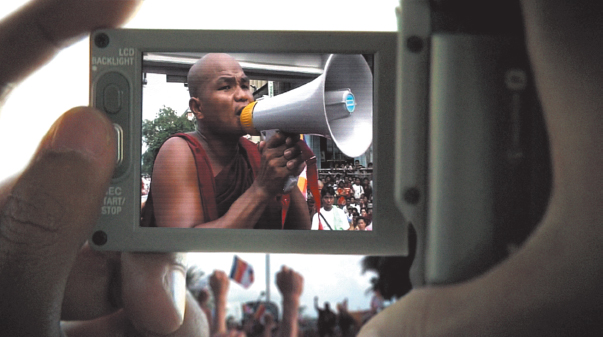The Public Journalism Movement
From the late 1980s through the 1990s, a number of papers experimented with ways to involve readers more actively in the news process. These experiments surfaced primarily at midsize daily papers, including the Charlotte Observer, the Wichita Eagle, the Virginian-Pilot, and the Minneapolis Star Tribune. Davis “Buzz” Merritt, editor and vice president of the Wichita Eagle at the time, defined key aspects of public journalism:
- It moves beyond the limited mission of “telling the news” to a broader mission of helping public life go well, and acts out that imperative. …
- It moves from detachment to being a fair-minded participant in public life. …
- It moves beyond only describing what is “going wrong” to imagining what “going right” would be like. …
- It moves from seeing people as consumers—as readers or nonreaders, as bystanders to be informed—to seeing them as a public, as potential actors in arriving at democratic solutions to public problems.42

Public journalism is best imagined as a conversational model for news practice. Modern journalism had drawn a distinct line between reporter detachment and community involvement; public journalism—driven by citizen forums, community conversations, and even talk shows—obscured this line.
In the 1990s—before the full impact of the Internet—public journalism served as a response to the many citizens who felt alienated from participating in public life in a meaningful way. This alienation arose, in part, from viewers who watched passively as the political process seemed to play out in the news and on TV between the party operatives and media pundits. Public journalism was a way to involve both the public and journalists more centrally in civic and political life. Editors and reporters interested in addressing citizen alienation—and reporter cynicism—began devising ways to engage people as conversational partners in determining the news. In an effort to draw the public into discussions about community priorities, these journalists began sponsoring citizen forums, where readers would have a voice in shaping aspects of the news that directly affected them.
An Early Public Journalism Project
“The idea is to frame stories from the citizen’s view, rather than inserting man-in-the-street quotes into a frame dominated by professionals.”
JAY ROSEN, NYU, 1995
Although isolated citizen projects and reader forums are sprinkled throughout the history of journalism, the public journalism movement began in earnest in 1987 in Columbus, Georgia. The city was suffering from a depressed economy, an alienated citizenry, and an entrenched leadership. In response, a team of reporters from the Columbus Ledger-Enquirer surveyed and talked with community leaders and other citizens about the future of the city. The paper then published an eight-part series based on the findings.
When the provocative series evoked little public response, the paper’s leadership realized there was no mechanism or forum for continuing the public discussions about the issues raised in the series. Consequently, the paper created such a forum by organizing a town meeting and helped create a new civic organization to tackle issues such as racial tension and teenage antisocial behavior.
The Columbus project generated public discussion, involved more people in the news process, and eased race and class tensions by bringing various groups together in public conversations. In the newsroom, the Ledger-Enquirer tried to reposition the place of journalists in politics: “Instead of standing outside the political community and reporting on its pathologies, they took up residence within its borders.”43
Criticizing Public Journalism
By 2000, more than a hundred newspapers, many teamed with local television and public radio stations, had practiced some form of public journalism. Yet many critics remained skeptical of the experiment, raising a number of concerns including the weakening of four journalistic hallmarks: editorial control, credibility, balance, and diverse views.44
First, some editors and reporters argued that public journalism was co-opted by the marketing department, merely pandering to what readers wanted and taking editorial control away from newsrooms. They believed that focus group samples and consumer research—tools of marketing, not journalism—blurred the boundary between the editorial and business functions of a paper. Some journalists also feared that as they became more active in the community, they may have been perceived as community boosters rather than as community watchdogs.
Second, critics worried that public journalism compromised the profession’s credibility, which many believe derives from detachment. They argued that public journalism turned reporters into participants rather than observers. However, as the Wichita Eagle’s editor Davis Merritt pointed out, professionals who have credibility “share some basic values about life, some common ground about common good.” Yet many journalists have insisted they “don’t share values with anyone; that [they] are value-neutral.”45 Merritt argued that, as a result, modern journalism actually has little credibility with the public, which the Pew Research Center’s annual credibility surveys bear out.
Third, critics also contended that public journalism undermined “balance” and the both-sides-of-a-story convention by constantly seeking common ground and community consensus; therefore, it ran the risk of dulling the rough edges of democratic speech. Public journalists countered that they were trying to set aside more room for centrist positions. Such positions were often representative of many in the community but were missing in the mainstream news, which has been more interested in the extremist views that make for a more dramatic story.
Fourth, many traditional reporters asserted that public journalism, which they considered merely a marketing tool, had not addressed the changing economic structure of the news business. With more news outlets in the hands of fewer owners, both public journalists and traditional reporters needed to raise tough questions about the disappearance of competing daily papers and newsroom staff cutbacks at local monopoly newspapers. Facing little competition, in 2010 and 2011 newspapers continued to cut reporting staffs and expensive investigative projects, reduced the space for news, or converted to online-only operations. While such trends temporarily helped profits and satisfied stockholders, they limited the range of stories told and views represented in a community.